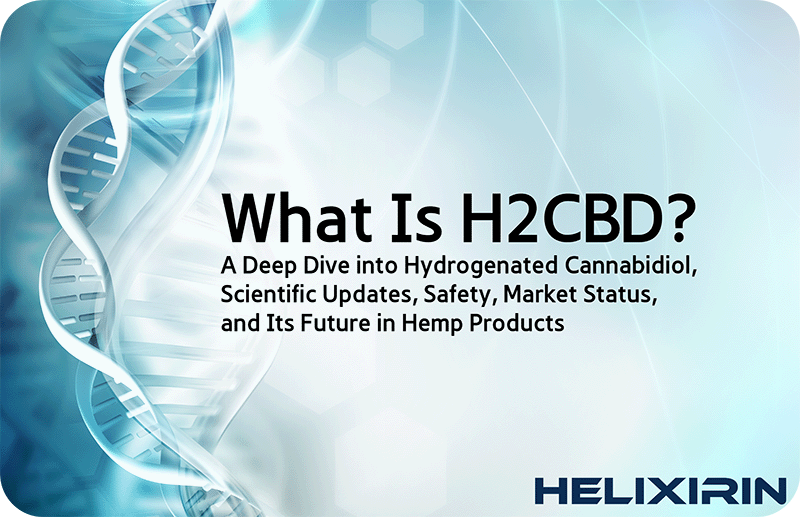
What Is H2CBD? A Deep Dive into Hydrogenated Cannabidiol, Scientific Updates, Safety, Market Status, and Its Future in Hemp Products
What Is H2CBD? A Deep Dive into Hydrogenated Cannabidiol, Scientific Updates, Safety, Market Status, and Its Future in Hemp Products
Introduction
H2CBD (8,9-dihydrocannabidiol) is a fully synthetic hydrogenated cannabinoid emerging as an innovative alternative to traditional CBD. While cannabinoids like CBD and THC have long dominated the wellness, pharmaceutical, and hemp product markets, hydrogenated versions—created through established chemical methods—hold significant promise for safety and purity, as well as resolving persistent legal, supply chain, and health challenges.
What is H2CBD? Chemistry and Production
H2CBD is produced by adding two hydrogen atoms to the CBD molecule using a process called hydrogenation. Unlike H4CBD (with four hydrogens), H2CBD maintains a structure nearly identical to natural CBD but with subtle, meaningful differences that impact its effects and safety.
Key facts:
-
Synthetic origin: H2CBD can be synthesized from inexpensive, non-cannabis starting materials, eliminating dependence on hemp farming.
-
Composition: It is a white, crystalline powder, odorless and flavorless, soluble in oils and commonly used solvents.
-
First produced: H2CBD was first synthesized in 1940 by chemist Alexander R. Todd, a Nobel laureate for his contributions to nucleotide chemistry.
How Does H2CBD Differ from CBD and Other Cannabinoids?
-
Non-intoxicating: H2CBD is non-psychoactive and cannot be enzymatically or chemically converted into THC, even in acidic stomach conditions, sidestepping legal and regulatory concerns.
-
Bioactivity: While chemically similar to CBD, hydrogenation subtly changes receptor activity—H2CBD binds weakly to the CB1 receptor, minimizing psychotropic potential.
-
Production: Synthetic manufacturing enables high-purity, large-scale production, free from agricultural contaminants like pesticides or mycotoxins.
Scientific Research and Benefits
1. Medical Potential
-
Epilepsy & Anti-seizure: Animal tests show H2CBD matches CBD in reducing seizures, especially in rodent models of epilepsy. This points toward pharmaceutical potential as a safe antiepileptic drug candidate.
-
Anti-inflammatory & Antioxidant: H2CBD exerts strong anti-inflammatory effects by interfering with key cell signaling pathways (e.g., NF-κB and AKT), reducing inflammation and oxidative stress—mechanisms also targeted by CBD.
-
Neuroprotective properties: Early research suggests H2CBD, like CBD, helps protect neurons from injury, making it an intriguing prospect in neurodegenerative disease research.
2. Safety Profile
-
No habit-forming potential: Studies show H2CBD lacks rewarding or reinforcing effects; it does not produce dependence or a “high”.
-
Not a controlled substance: Its synthetic origins and inability to convert to THC mean H2CBD is generally not classified as a controlled cannabinoid in most countries.
-
Toxicity: Preclinical research to date has not revealed organ toxicity, mutations, or carcinogenic risks; however, thorough human clinical data is still needed.
3. Pharmaceutical & Consumer Advantages
-
Batch consistency: Lab synthesis ensures every batch is chemically identical—unlike plant extracts, which can vary due to genetics, climate, and soil.
-
Environmental benefits: Because it skips agriculture, H2CBD production reduces water use, land needs, and avoids pesticide/herbicide runoff.
-
Legal clarity: Its legal standing reduces risk for researchers, manufacturers, and consumers where CBD or other cannabinoids are tightly regulated.
Emerging Applications and Use Cases
-
Pharmaceutical products: H2CBD is under investigation for epilepsy, anxiety, inflammation, and neurodegenerative disease therapies.
-
Wellness & skincare: Its antioxidant properties and purity profile are finding favor for premium skincare and topical wellness formulations.
-
Dietary supplements & functional foods: Regulatory clarity could accelerate its adoption as an ingredient in supplements or functional drinks, especially with increasing bans or restrictions on plant-derived CBD in some markets.
Drawbacks and Limitations
-
Limited availability: H2CBD is not yet widely available in over-the-counter products due to ongoing research, regulatory approvals, and limited manufacturer uptake.
-
Regulatory uncertainty: While generally clear of controlled substance definitions, each jurisdiction handles novel cannabinoids differently—consulting legal guidance is essential.
-
Clinical data gaps: Human clinical trials lag behind those for CBD, making it critical for consumers and scientists to await further research, especially on long-term safety.
Safety and Regulatory Considerations
-
Manufacturing quality: Because hydrogenation uses chemical catalysts, final H2CBD products must be strictly purified and tested to eliminate metals or residues.
-
Quality control: Reputable suppliers will provide third-party lab certificates of analysis for every batch, detailing purity, composition, and absence of contaminants.
-
Consumer advice: Only purchase from trusted, transparent sources with full documentation and professional oversight.
The Future of H2CBD in Hemp and Health Products
H2CBD sits at the cutting edge of cannabinoid science, offering a safer, purer, and more legally accessible profile than many hemp derivatives. As research progresses, expect:
-
More clinical studies examining its safety, efficacy, and range of health effects.
-
Increased integration into pharmaceutical pipelines for seizure, inflammation, and neurodegenerative disorders.
-
Expansion in wellness and skincare markets driven by demand for cannabinoid innovation and clean-label, sustainable ingredients.
For now, scientists and the hemp industry are watching—potentially on the verge of another leap forward in the medical and commercial use of cannabinoids.
This article is for educational purposes only and does not constitute medical or legal advice. Always consult qualified professionals regarding use or purchase of cannabinoids and related supplements.





